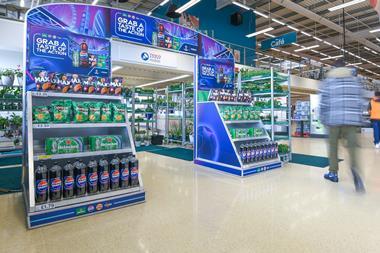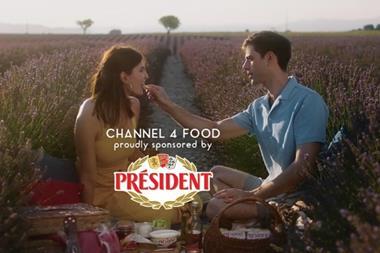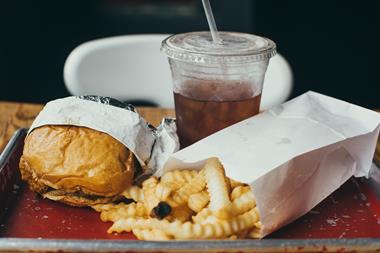Some boys never grow up. Well, at least that’s what PepsiCo, maker of Walkers Monster Munch, thinks. In an attempt to reverse falling sales, it has decided to go forward by going back, returning the crisp brand to its original packaging, recipe and flavours and targeting the ‘core group’ of 18 to 24-year-old men who remember the brand from before its 1995 makeover.
It’s not the only brand that’s offering shoppers a nostalgic escape from today’s harsh economic reality by going retro. Arguably the highest profile is Premier Foods’ Hovis, which has gone the whole kit and caboodle of revamping its packaging and launching a slick multi-million pound ad campaign in a bid to re-invoke brand loyalty (see p49), though there have been plenty of others – Tizer, Poppets and Quality Street to name but three.
The last couple of years also marked the return of plenty of old favourites to supermarket shelves after years in the wilderness – think Opal Fruits, Findus Fish Fingers, ice lolly Jubbly and chocolate bar Drifter. Nostalgia is big business, it seems. But given the number of brands hitching themselves to the retro bandwagon at the moment, is it as effective a marketing strategy as their owners think it is?
But nowhere is the trend stronger than in the grocery sector. That’s because the big food and drink brands rely more heavily than most on emotions, one of which is nostalgia, says Mark Wickens, chairman of brand agency Brandhouse.
“The world portrayed by the media is quite a scary place,” he notes. “What happens at these times is that people retreat to ‘mum’ and the brands they had when they were kids. The emotional benefits of nostalgia brands are security, safety and comfort.”
Where nostalgia and retro brands are most effective is in bringing renewed interest to the supermarket aisles, argues Wickens. “When you come across an old brand and are interested in trying it again, it adds wonder and surprise to your shopping. It’s about engaging emotion at point of sale.”
And what category better conjures up emotion than confectionery, which evokes memories of treats bought with hard-earned pocket money. One of the most significant recent brand resurrections was Cadbury’s Wispa chocolate bar. The thick, bubble-filled bar launched in 1983, but was axed in 2003 in the wake of falling sales. To some degree, Dairy Milk Bubbles took its place but consumers had reserved a place in their hearts for the original thick-block version and last October, Cadbury measured depth of feeling with a limited edition re-run. It sold 20 million bars in seven weeks, prompting the company to re-introduce the brand permanently.
Although consumers have always been passionate about certain brands, the Wispa case demonstrated the importance of actively re-engaging with them. And the best way to revitalise an old brand? New media, of course. Facebook and other social networking sites have not only revolutionised the way consumers communicate with one another, they have also changed the way they communicate with brands and enfranchised a whole generation of consumer lobbyists.
It was the power of this new lobby that got the ball rolling for Wispa, says Kate Harding, trade communications manager at Cadbury. “More than 40,000 people are now talking about Wispa on Facebook alone. That’s an increase of 31,500 online fans since the re-launch last autumn and those were figures we couldn’t ignore.”
Joe Staton, planning director for consultants Future Foundation, says cyberspace offers a fertile environment for nostalgia to flourish and by definition the brands that tap into it. “Brands already listen to customers, but social networking enables them to actively have a dialogue,” he says.
While he questions whether elements of the Wispa campaign were a case of “the tail wagging the dog”, the PR benefits have been clear, he believes. Others are less convinced, if not of the short-term merits of retro mania, certainly of its long-term value. Even if, as may well be the case with Wispa, consumer demand was behind its revival, there’s no guarantee that people will remain loyal. It doesn’t say much for the current health of the industry’s NPD either.
However, reviving long-forgotten brands is a cheaper and possibly safer way to shake up a category in a competitive market than a completely new launch. In difficult economic times, marketing directors are under pressure to squeeze every last drop of value out of their brands. Innovation is expensive and comes with huge levels of failure, says Staton.
“The marketing department has the finance director breathing down their necks, so although you may say it’s the refuge of a lazy marketer, they have to make their assets sweat. And anything in the portfolio they can re-present, well why not try it?”
That’s not to say it will be an effective strategy in the long run, says Graham Hales, executive director at brand consultancy Interbrand. “I hesitate to say it’s going to be here for a long time. Everything is an evolution and this is another stage. Milk it for as long as there’s a benefit, but it’s not here forever.”
But some brands deserve a second chance, he agrees. “It comes out of focus groups where someone shows a concept from yesteryear and it draws favour from consumers. Potentially it’s a bit of recycling – it’s cheap to do, but creates news and noise around the brand,” he explains.
An extra benefit is the potential to attract two sets of consumers. So while Monster Munch’s relaunch is specifically aimed at grown men with sentimental childhood memories, there is also the opportunity to win over a new generation of kids too.
The key is to appeal on both a nostalgic and contemporary level. Swizzels Matlow has produced confectionery brands including Love Hearts, Refreshers and Drumsticks for 80 years. Many adults fondly remember its products from their childhoods, but the company does not see itself as old-fashioned or focused on the past.
“What you find is that a young child doesn’t see our brand as nostalgic,” says communications director Andrew Matlow. “It’s their elders who see them and think ‘I remember those’ and all of a sudden a wave of memories comes back to them.”
While Wispa is enjoying a second childhood and Hovis has proudly gone back to its roots, there are other brands which, despite their retro appeal, are unlikely to have the same power over the modern consumer they had in their heydays, chiefly because of changing dietary habits.
Seventies favourite Smash may have had one of the most memorable campaigns in the history of TV advertising with its chortling aliens, but instant potato mash no longer feels like a product of our time, despite its relaunch this year with new packaging and healthier recipes.
“It’s difficult to see consumers moving back to instant mash potato,” says Hales. “You have to recast these nostalgic products to ensure the message is right for 2008.”
Spam, which is loved and loathed in equal measure by the generation brought up on Spam fritters, has also tried to move with the times by introducing a variety of new recipes. It doesn’t command the same shelf space it used to enjoy, though its makers are winning over a new audience. The challenge, admits the company, is getting younger people over the perceived quality barrier to try the brand in the first instance.
Those that are successful at reinventing themselves make sure the core brand values resonate with today’s consumers. When Barr Soft Drinks relaunched Tizer in 2007 in a bid to boost sales, it did so by going back to its original 1924 recipe. Not only did this make good PR, it also appealed to today’s parents, as it meant ditching artificial colours, sweeteners and flavours and including 10% natural fruit juice. The bottle also featured a retro 1980s pack design.
So who’ll be next down the retro road? There are plenty of childhood favourites that we in The Grocer office feel could be ripe for revival (see box-out). No doubt more will be pondering a return at least to more retro packaging as people continue to seek comfort in nostalgia. Whether retro brands betray a lack of innovative flair on the part of their owners, is academic.
The evidence is that they can and do work. “When you have a massive choice, you turn to trusted, familiar brands where there’s a connection,” says Staton.
The question is how long that connection will last.
It’s not the only brand that’s offering shoppers a nostalgic escape from today’s harsh economic reality by going retro. Arguably the highest profile is Premier Foods’ Hovis, which has gone the whole kit and caboodle of revamping its packaging and launching a slick multi-million pound ad campaign in a bid to re-invoke brand loyalty (see p49), though there have been plenty of others – Tizer, Poppets and Quality Street to name but three.
The last couple of years also marked the return of plenty of old favourites to supermarket shelves after years in the wilderness – think Opal Fruits, Findus Fish Fingers, ice lolly Jubbly and chocolate bar Drifter. Nostalgia is big business, it seems. But given the number of brands hitching themselves to the retro bandwagon at the moment, is it as effective a marketing strategy as their owners think it is?
Hovis steps back in time to step forward in sales
The culmination of Premier Foods’ relaunch of its Hovis brand – the ultimate in retro branding – came two weeks ago, when its 122-second advertising extravaganza hit the screens in the Coronation Street break. The history of the brand is brought to life by a boy returning home from the shops with his loaf of Hovis bread back in 1886. As he walks home, the street scenes change to reflect key moments in British history. Among the milestones featured are the suffragette movement, the world wars, the miners’ strike and the millennium celebrations. With the strapline ‘As good today as it’s always been’, there can be no mistaking Hovis’s intent to stir up nostalgic memories for its bread. The £13m marketing campaign will support the new packaging and format sizes that have been introduced by Premier in a bid to regain market share. With the previous innovative and award-winning pack being dropped, the company has instead turned to a more conservative, retro design. It features a ‘boy with bike’ logo in reference to the iconic Ridley Scott TV advertising from 1973. Premier has also reintroduced its Little Brown Loaf. The 400g unsliced loaf was first introduced in 1886 and carries the brand name embossed on the side. “The launch taps into the consumer retro trend, with paper packaging giving it distinctive shelf appeal,” says Hovis marketing director Jon Goldstone. The company hopes the reintroduction of the smaller sized loaf will appeal to the growing number of one and two-person households as well as those looking to reduce food wastage. One advantage for Hovis is that in harking back to its roots, it can focus on brand credentials such as its wholemeal content, which are in keeping with current healthy-eating trends. This investment is critical for Hovis as it fights to regain share in the £1.6bn bread category. In August, Hovis lagged behind Warburtons with value sales of £384m compared to the market leader’s £563m, according to Nielsen.
With 2008 destined to be remembered as the year of financial meltdown, it’s not surprising people are keen to look back on the good old days. When times are tough, sentimentality grows and yesteryear transforms itself into a safe haven from today’s woes. The evidence is everywhere. From a new lease of life for the bubble car, with Fiat updating its 500 model, to news that kids’ programmes Rentaghost and Worzel Gummidge may once again hit our screens, nothing is immune to the nostalgia bug.The culmination of Premier Foods’ relaunch of its Hovis brand – the ultimate in retro branding – came two weeks ago, when its 122-second advertising extravaganza hit the screens in the Coronation Street break. The history of the brand is brought to life by a boy returning home from the shops with his loaf of Hovis bread back in 1886. As he walks home, the street scenes change to reflect key moments in British history. Among the milestones featured are the suffragette movement, the world wars, the miners’ strike and the millennium celebrations. With the strapline ‘As good today as it’s always been’, there can be no mistaking Hovis’s intent to stir up nostalgic memories for its bread. The £13m marketing campaign will support the new packaging and format sizes that have been introduced by Premier in a bid to regain market share. With the previous innovative and award-winning pack being dropped, the company has instead turned to a more conservative, retro design. It features a ‘boy with bike’ logo in reference to the iconic Ridley Scott TV advertising from 1973. Premier has also reintroduced its Little Brown Loaf. The 400g unsliced loaf was first introduced in 1886 and carries the brand name embossed on the side. “The launch taps into the consumer retro trend, with paper packaging giving it distinctive shelf appeal,” says Hovis marketing director Jon Goldstone. The company hopes the reintroduction of the smaller sized loaf will appeal to the growing number of one and two-person households as well as those looking to reduce food wastage. One advantage for Hovis is that in harking back to its roots, it can focus on brand credentials such as its wholemeal content, which are in keeping with current healthy-eating trends. This investment is critical for Hovis as it fights to regain share in the £1.6bn bread category. In August, Hovis lagged behind Warburtons with value sales of £384m compared to the market leader’s £563m, according to Nielsen.
But nowhere is the trend stronger than in the grocery sector. That’s because the big food and drink brands rely more heavily than most on emotions, one of which is nostalgia, says Mark Wickens, chairman of brand agency Brandhouse.
“The world portrayed by the media is quite a scary place,” he notes. “What happens at these times is that people retreat to ‘mum’ and the brands they had when they were kids. The emotional benefits of nostalgia brands are security, safety and comfort.”
Where nostalgia and retro brands are most effective is in bringing renewed interest to the supermarket aisles, argues Wickens. “When you come across an old brand and are interested in trying it again, it adds wonder and surprise to your shopping. It’s about engaging emotion at point of sale.”
And what category better conjures up emotion than confectionery, which evokes memories of treats bought with hard-earned pocket money. One of the most significant recent brand resurrections was Cadbury’s Wispa chocolate bar. The thick, bubble-filled bar launched in 1983, but was axed in 2003 in the wake of falling sales. To some degree, Dairy Milk Bubbles took its place but consumers had reserved a place in their hearts for the original thick-block version and last October, Cadbury measured depth of feeling with a limited edition re-run. It sold 20 million bars in seven weeks, prompting the company to re-introduce the brand permanently.
Although consumers have always been passionate about certain brands, the Wispa case demonstrated the importance of actively re-engaging with them. And the best way to revitalise an old brand? New media, of course. Facebook and other social networking sites have not only revolutionised the way consumers communicate with one another, they have also changed the way they communicate with brands and enfranchised a whole generation of consumer lobbyists.
It was the power of this new lobby that got the ball rolling for Wispa, says Kate Harding, trade communications manager at Cadbury. “More than 40,000 people are now talking about Wispa on Facebook alone. That’s an increase of 31,500 online fans since the re-launch last autumn and those were figures we couldn’t ignore.”
Joe Staton, planning director for consultants Future Foundation, says cyberspace offers a fertile environment for nostalgia to flourish and by definition the brands that tap into it. “Brands already listen to customers, but social networking enables them to actively have a dialogue,” he says.
While he questions whether elements of the Wispa campaign were a case of “the tail wagging the dog”, the PR benefits have been clear, he believes. Others are less convinced, if not of the short-term merits of retro mania, certainly of its long-term value. Even if, as may well be the case with Wispa, consumer demand was behind its revival, there’s no guarantee that people will remain loyal. It doesn’t say much for the current health of the industry’s NPD either.
However, reviving long-forgotten brands is a cheaper and possibly safer way to shake up a category in a competitive market than a completely new launch. In difficult economic times, marketing directors are under pressure to squeeze every last drop of value out of their brands. Innovation is expensive and comes with huge levels of failure, says Staton.
“The marketing department has the finance director breathing down their necks, so although you may say it’s the refuge of a lazy marketer, they have to make their assets sweat. And anything in the portfolio they can re-present, well why not try it?”
That’s not to say it will be an effective strategy in the long run, says Graham Hales, executive director at brand consultancy Interbrand. “I hesitate to say it’s going to be here for a long time. Everything is an evolution and this is another stage. Milk it for as long as there’s a benefit, but it’s not here forever.”
But some brands deserve a second chance, he agrees. “It comes out of focus groups where someone shows a concept from yesteryear and it draws favour from consumers. Potentially it’s a bit of recycling – it’s cheap to do, but creates news and noise around the brand,” he explains.
An extra benefit is the potential to attract two sets of consumers. So while Monster Munch’s relaunch is specifically aimed at grown men with sentimental childhood memories, there is also the opportunity to win over a new generation of kids too.
The key is to appeal on both a nostalgic and contemporary level. Swizzels Matlow has produced confectionery brands including Love Hearts, Refreshers and Drumsticks for 80 years. Many adults fondly remember its products from their childhoods, but the company does not see itself as old-fashioned or focused on the past.
“What you find is that a young child doesn’t see our brand as nostalgic,” says communications director Andrew Matlow. “It’s their elders who see them and think ‘I remember those’ and all of a sudden a wave of memories comes back to them.”
Brands that came back...
Findus Fish Fingers returned this year after 11 years, this time made with Alaskan pollock fillet rather than cod. Opal Fruits returned for a limited period to Asda this year. Wispa is being brought back in October after concerted online consumer lobbying. Jubbly, the iconic 1950s ice lolly, was revived in 2005. Drifter returned in May 2007 after a brief period off the shelves. Walkers Worcester Sauce crisps were reintroduced after being dropped due to poor sales.
...and brands ripe for a comeback
Spangles, Cresta, Burton’s Fish and Chips, Cabana bars, Corona Quatro, Football Crazy, Traffic Light lollies, Trio Biscuits, Pacers, Birds Eye Alphabites, Nestlé Secret, Piglet crisps
What makes a good retro brand
A strong USP; integrity; widely remembered; emotional resonance; an updated message.
With retro packaging providing a good route to added shelf standout, even new brands are adopting the look in a bid to catch the consumer’s eye. Recently launched Dragonfly Teas’ Tick Tock tea packaging is distinctly retro looking and Look What We Found’s ready-meal recipes and packaging proudly hark back to British classics such as mutton stew and Lancashire hot pot.
The biggest impact nostalgia brands have is in their ability to make shoppers smile, Staton says. But it is a fine line for a brand to tread. The successful may make consumers smile at fond memories, but the failures will have them laughing for the wrong reasons. When a brand crosses over into jokedom, it’s time to let it go.Findus Fish Fingers returned this year after 11 years, this time made with Alaskan pollock fillet rather than cod. Opal Fruits returned for a limited period to Asda this year. Wispa is being brought back in October after concerted online consumer lobbying. Jubbly, the iconic 1950s ice lolly, was revived in 2005. Drifter returned in May 2007 after a brief period off the shelves. Walkers Worcester Sauce crisps were reintroduced after being dropped due to poor sales.
...and brands ripe for a comeback
Spangles, Cresta, Burton’s Fish and Chips, Cabana bars, Corona Quatro, Football Crazy, Traffic Light lollies, Trio Biscuits, Pacers, Birds Eye Alphabites, Nestlé Secret, Piglet crisps
What makes a good retro brand
A strong USP; integrity; widely remembered; emotional resonance; an updated message.
While Wispa is enjoying a second childhood and Hovis has proudly gone back to its roots, there are other brands which, despite their retro appeal, are unlikely to have the same power over the modern consumer they had in their heydays, chiefly because of changing dietary habits.
Seventies favourite Smash may have had one of the most memorable campaigns in the history of TV advertising with its chortling aliens, but instant potato mash no longer feels like a product of our time, despite its relaunch this year with new packaging and healthier recipes.
“It’s difficult to see consumers moving back to instant mash potato,” says Hales. “You have to recast these nostalgic products to ensure the message is right for 2008.”
Spam, which is loved and loathed in equal measure by the generation brought up on Spam fritters, has also tried to move with the times by introducing a variety of new recipes. It doesn’t command the same shelf space it used to enjoy, though its makers are winning over a new audience. The challenge, admits the company, is getting younger people over the perceived quality barrier to try the brand in the first instance.
Those that are successful at reinventing themselves make sure the core brand values resonate with today’s consumers. When Barr Soft Drinks relaunched Tizer in 2007 in a bid to boost sales, it did so by going back to its original 1924 recipe. Not only did this make good PR, it also appealed to today’s parents, as it meant ditching artificial colours, sweeteners and flavours and including 10% natural fruit juice. The bottle also featured a retro 1980s pack design.
So who’ll be next down the retro road? There are plenty of childhood favourites that we in The Grocer office feel could be ripe for revival (see box-out). No doubt more will be pondering a return at least to more retro packaging as people continue to seek comfort in nostalgia. Whether retro brands betray a lack of innovative flair on the part of their owners, is academic.
The evidence is that they can and do work. “When you have a massive choice, you turn to trusted, familiar brands where there’s a connection,” says Staton.
The question is how long that connection will last.















No comments yet